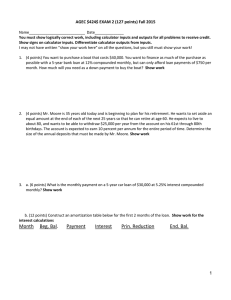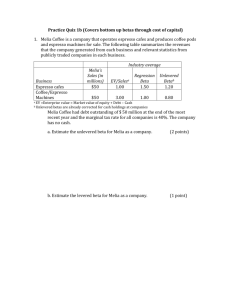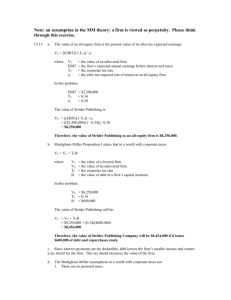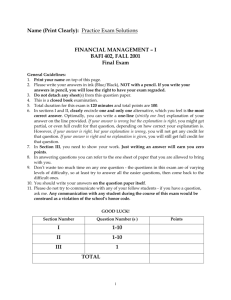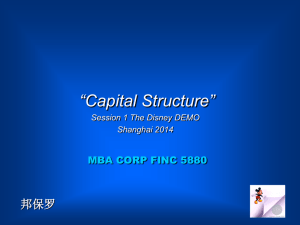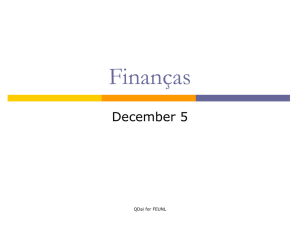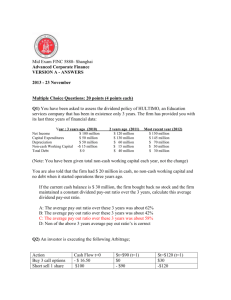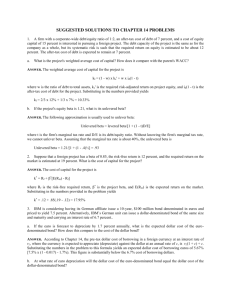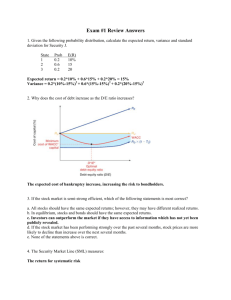Chapter 4
advertisement
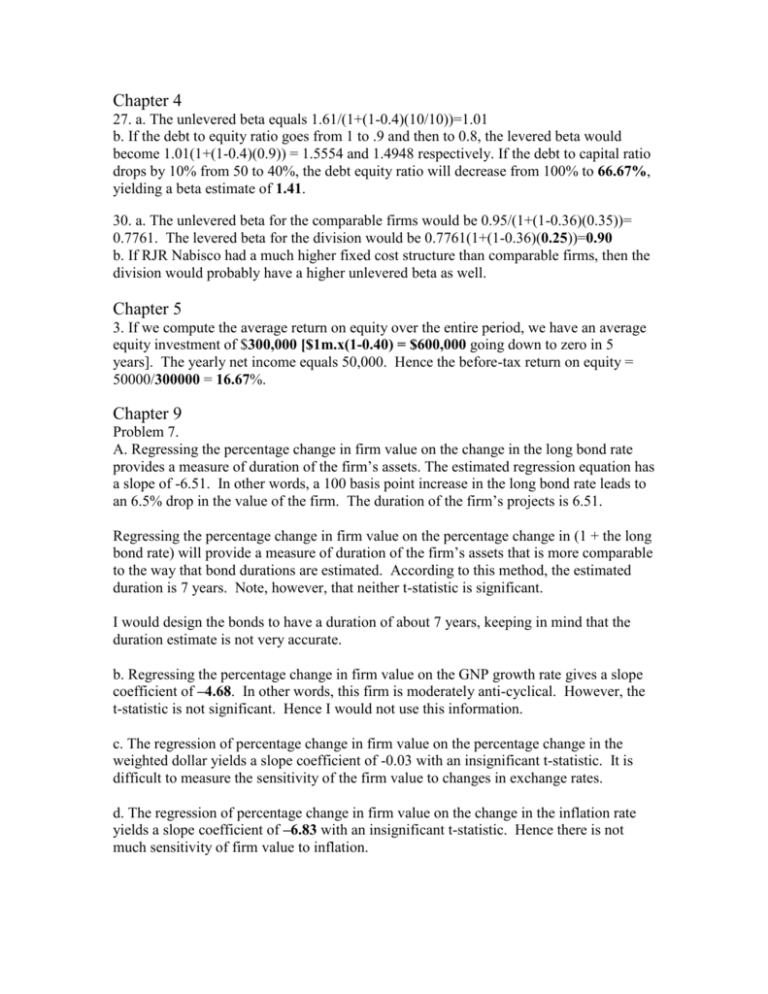
Chapter 4 27. a. The unlevered beta equals 1.61/(1+(1-0.4)(10/10))=1.01 b. If the debt to equity ratio goes from 1 to .9 and then to 0.8, the levered beta would become 1.01(1+(1-0.4)(0.9)) = 1.5554 and 1.4948 respectively. If the debt to capital ratio drops by 10% from 50 to 40%, the debt equity ratio will decrease from 100% to 66.67%, yielding a beta estimate of 1.41. 30. a. The unlevered beta for the comparable firms would be 0.95/(1+(1-0.36)(0.35))= 0.7761. The levered beta for the division would be 0.7761(1+(1-0.36)(0.25))=0.90 b. If RJR Nabisco had a much higher fixed cost structure than comparable firms, then the division would probably have a higher unlevered beta as well. Chapter 5 3. If we compute the average return on equity over the entire period, we have an average equity investment of $300,000 [$1m.x(1-0.40) = $600,000 going down to zero in 5 years]. The yearly net income equals 50,000. Hence the before-tax return on equity = 50000/300000 = 16.67%. Chapter 9 Problem 7. A. Regressing the percentage change in firm value on the change in the long bond rate provides a measure of duration of the firm’s assets. The estimated regression equation has a slope of -6.51. In other words, a 100 basis point increase in the long bond rate leads to an 6.5% drop in the value of the firm. The duration of the firm’s projects is 6.51. Regressing the percentage change in firm value on the percentage change in (1 + the long bond rate) will provide a measure of duration of the firm’s assets that is more comparable to the way that bond durations are estimated. According to this method, the estimated duration is 7 years. Note, however, that neither t-statistic is significant. I would design the bonds to have a duration of about 7 years, keeping in mind that the duration estimate is not very accurate. b. Regressing the percentage change in firm value on the GNP growth rate gives a slope coefficient of –4.68. In other words, this firm is moderately anti-cyclical. However, the t-statistic is not significant. Hence I would not use this information. c. The regression of percentage change in firm value on the percentage change in the weighted dollar yields a slope coefficient of -0.03 with an insignificant t-statistic. It is difficult to measure the sensitivity of the firm value to changes in exchange rates. d. The regression of percentage change in firm value on the change in the inflation rate yields a slope coefficient of –6.83 with an insignificant t-statistic. Hence there is not much sensitivity of firm value to inflation. e. Given the noisiness of the estimates, I would try and obtain other estimates perhaps using fundamental analysis. Another alternative is to use industry averages to measure firm sensitivities. Problem 8. The sensitivity of operating income changes to changes in the macroeconomic variables are as follows: bond rate GNP growth weighted dollar inflation 9.248083 5.25 -0.10 4.05 Once again, the t-statistics are barely significant. Chapter 10 Problem 29 a. Current market value of debt = current market value of stock = $42 * 1 million = $42 million After $5 million of debt is retired, total debt becomes $37 million EPS = (15,000,000 - 37,000,000*10%) (1 - 40%) / (1,000,000 - 100,000) = $7.53 b. Current EPS = (15,000,000 - 42,000,000 *10%) (1 - 40%) / 1,000,000 = $6.48 Current P/E ratio = $42 / $6.48 = 6.48 The new price would be $7.53*6.48 or $48.79 per share. It is lower than the tendering price of $50. The management would probably argue that the P/E ratio would be higher, leading to a higher price. c. It the stocks are bought back at the ongoing market price, it is less likely that the market would believe the argument made by the management that the stock is underpriced. d. The answer to (b) and (c) may differ if the management is allowed to tender shares. The prices would go down because the market may conclude that the management is trying to unload its shares. Problem 31 a. Without Borrowing 20 EBIT Interest Exp. 0 20 EBT 10 Taxes 10 Net Income No. of Shares 100,000 100 EPS With Borrowing 20 4.8 15.2 7.6 7.6 60,000 126.67 b. The interest rate on debt would have to be 12.5% for the EPS effect to disappear. Chapter 11 Problem 13 Year Net Income (Cap Ex - Depr) (1-DR) $485.10 $151.96 1996 $533.61 $164.11 1997 $586.97 $177.24 1998 $645.67 $191.42 1999 $710.23 $206.73 2000 Ch WC (1-DR) FCFE $8.75 $9.19 $9.65 $10.13 $10.64 $324.39 $360.31 $400.08 $444.12 $492.86 This is the amount that the company can afford to pay in dividends. b. The perceived uncertainty in these cash flows will make me more conservative in paying out the entire amount in FCFE in the year in which I make it. Chapter 12 Problem 15 b. Year Deprec'n EBIT EBIT(1-t) Cap Ex FCFF 0 $350 $560 $336 $420 $266 1 $364 $594 $356 $437 $283 2 $379 $629 $378 $454 $302 3 $394 $667 $400 $472 $321 4 $409 $707 $424 $491 $342 5 $426 $749 $450 $511 $364 TY $443.04 $778.96 $468 $531.44 $379.60 Term Val $5,021 Value of the Division = 283/1.1156 + 302/1.11562 + 321/1.11563 + 342/1.11564 + (364 + 5021)/1.11565 = $ 4,062 million
